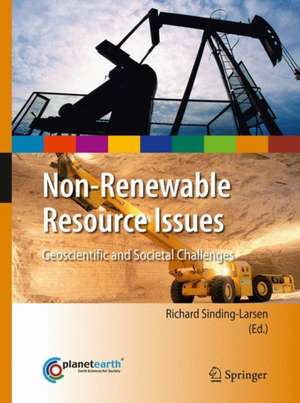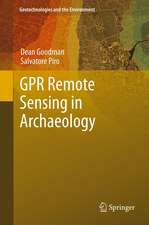Non-Renewable Resource Issues: Geoscientific and Societal Challenges: International Year of Planet Earth
Editat de Richard Sinding-Larsen, Friedrich-W. Wellmeren Limba Engleză Hardback – 31 mar 2012
Growing demands have begun to restrict availability of these resources. The Earth is not running out of critical mineral resources – at least for the near future – but the ability to explore and extract these resources is being restricted in many regions by competing land use, as well as political and environmental issues.
Extraction of natural resources requires a clear focus on sustainable development, involving economic, environmental and socio-cultural aspects. Although we do not know what the most important resources will be in 100 years from now, we can be quite certain that society will still need energy and a wide range of raw materials. These resources will include oil and gas, coal, uranium, thorium, geothermal, metallic minerals, industrial and specialty minerals, including cement, raw materials, rare-earth elements. A global approach for assessing the magnitude and future availability of these resources is called for – an approach that, with appropriate internationalcollaboration, was started within the triennium of the International Year of Planet Earth. Some global mineral resource assessments, involving inter-governmental collaboration, have already been initiated. The International Year of Planet Earth helped to focus attention on how the geosciences can generate prosperity locally and globally, as well as sustainability issues in both developed and developing countries.
| Toate formatele și edițiile | Preț | Express |
|---|---|---|
| Paperback (1) | 562.59 lei 39-44 zile | |
| SPRINGER NETHERLANDS – 23 aug 2016 | 562.59 lei 39-44 zile | |
| Hardback (1) | 655.60 lei 6-8 săpt. | |
| SPRINGER NETHERLANDS – 31 mar 2012 | 655.60 lei 6-8 săpt. |
Preț: 655.60 lei
Preț vechi: 771.30 lei
-15% Nou
Puncte Express: 983
Preț estimativ în valută:
125.44€ • 131.68$ • 104.12£
125.44€ • 131.68$ • 104.12£
Carte tipărită la comandă
Livrare economică 10-24 aprilie
Preluare comenzi: 021 569.72.76
Specificații
ISBN-13: 9789048186785
ISBN-10: 9048186781
Pagini: 250
Ilustrații: XVIII, 252 p.
Dimensiuni: 178 x 254 x 20 mm
Greutate: 0.84 kg
Ediția:2012
Editura: SPRINGER NETHERLANDS
Colecția Springer
Seria International Year of Planet Earth
Locul publicării:Dordrecht, Netherlands
ISBN-10: 9048186781
Pagini: 250
Ilustrații: XVIII, 252 p.
Dimensiuni: 178 x 254 x 20 mm
Greutate: 0.84 kg
Ediția:2012
Editura: SPRINGER NETHERLANDS
Colecția Springer
Seria International Year of Planet Earth
Locul publicării:Dordrecht, Netherlands
Public țintă
ResearchCuprins
The exhaustion of mineral resources.- A truism or a state of mind?- Stretching the availability of non-renewable resources.- Challenges in the optimal management of remaining petroleum resources.- Uranium: The world's energy mineral.- Coal: an energy source for future world needs!?- Natural gas hydrates: Recent research and assessment developments.- Challenges of the European Mining Industry in the Years to Come.- Commision Raw Materials Initiative.- The metal market: A new corporate landscape emerging.- Developments and trends in the availability of non-ferrous mineral raw materials.- Future of metal mining in Europe - a fennoscandian perspective.- Tomorrow's gold resources: Where will we find them?- Global assessment of undiscovered mineral resources: Opportunities and challenges.- Marine minerals: A new perspective.- Ocean floor mining.- Rare earth elements: a new scope of mining for saving energy and environment.- Metals for a sustainable modern society.
Textul de pe ultima copertă
All the solid fuels fossil energy and mineral commodities we use come out of the Earth. Modern society is increasingly dependent on mineral and fossil energy sources. They differ in availability, cost of production, and geographical distribution. Even if solid fuels, fossil energy resources and mineral commodities are non-renewable, the extracted metals can to a large extent be recycled and used again and again. Although the stock of these secondary resources and their use increases, the world still needs and will continue to need primary mineral resources for the foreseeable future.
Growing demands have begun to restrict availability of these resources. The Earth is not running out of critical mineral resources – at least for the near future – but the ability to explore and extract these resources is being restricted in many regions by competing land use, as well as political and environmental issues.
Extraction of natural resources requires a clear focus on sustainable development, involving economic, environmental and socio-cultural aspects. Although we do not know what the most important resources will be in 100 years from now, we can be quite certain that society will still need energy and a wide range of raw materials. These resources will include oil and gas, coal, uranium, thorium, geothermal, metallic minerals, industrial and specialty minerals, including cement, raw materials, rare-earth elements. A global approach for assessing the magnitude and future availability of these resources is called for – an approach that, with appropriate internationalcollaboration, was started within the triennium of the International Year of Planet Earth. Some global mineral resource assessments, involving inter-governmental collaboration, have already been initiated. The International Year of Planet Earth helped to focus attention on how the geosciences can generate prosperity locally and globally, as well as sustainability issues in both developed and developing countries.
Growing demands have begun to restrict availability of these resources. The Earth is not running out of critical mineral resources – at least for the near future – but the ability to explore and extract these resources is being restricted in many regions by competing land use, as well as political and environmental issues.
Extraction of natural resources requires a clear focus on sustainable development, involving economic, environmental and socio-cultural aspects. Although we do not know what the most important resources will be in 100 years from now, we can be quite certain that society will still need energy and a wide range of raw materials. These resources will include oil and gas, coal, uranium, thorium, geothermal, metallic minerals, industrial and specialty minerals, including cement, raw materials, rare-earth elements. A global approach for assessing the magnitude and future availability of these resources is called for – an approach that, with appropriate internationalcollaboration, was started within the triennium of the International Year of Planet Earth. Some global mineral resource assessments, involving inter-governmental collaboration, have already been initiated. The International Year of Planet Earth helped to focus attention on how the geosciences can generate prosperity locally and globally, as well as sustainability issues in both developed and developing countries.
Caracteristici
The book provides guidelines on how to ascertain whether resource scarcity or abundance poses a threat to sustainable development It discusses how our improved knowledge of valuable geological resources can help with better planning, governance, social stability and advancement





















